Common menu bar links
Breadcrumb Trail
ARCHIVED - Expenditure Review of Federal Public Sector - Volume Two - Compensation Snapshop and Historical Perspective, 1990 to 2003
 This page has been archived.
This page has been archived.
Archived Content
Information identified as archived on the Web is for reference, research or recordkeeping purposes. It has not been altered or updated after the date of archiving. Web pages that are archived on the Web are not subject to the Government of Canada Web Standards. As per the Communications Policy of the Government of Canada, you can request alternate formats on the "Contact Us" page.
3. Why Overall Employment and Average Salary Increased
We now examine the issue of increasing salary and employment levels in some depth, within the limits of the available data, examining in turn:
- the management of Program Review staff reductions,
- transfers of work and employees to other employers,
- increases in service contract expenditures,
- increased spending for additional staff or salary increases, and
- changes in the composition of the workforce.
Management of Program Review staff reductions
Staff reductions initiated from 1994 to 1998 under Program Review were managed within departments. The specific decisions to eliminate positions were often taken one or more levels below the deputy minister. While the rationales for these decisions were undoubtedly diverse, anecdotally at least, in many instances jobs were reduced more than work, leaving workload pressures that would reassert themselves and lead to regrowth in the size of the public service.
During the Program Review period, the Early Departure Incentive and the Early Retirement Incentive encouraged employees to resign or retire early, to meet the need to reduce the size of the public service. The impact of these incentives on the composition of the workplace is examined in the final section of this chapter, as we examine changes in the composition of the workforce.
The Program Review exercise resulted in the most dramatic reduction in the population and cost of the federal public service in modern history. The total population of the core public service and separate employer domains declined from a high of 245,100 in 1992–93 to a low of 194,800 in 1994–95. While the size of the public service has largely rebounded since that time, the new composition of the workforce responds better to current needs, as some occupational groups have declined in size and others have expanded. Again, this phenomenon is discussed in detail in the final section of this chapter.
Transfers of work and employees to other employers
Some reductions in the size of the public service over the years were in fact transfers of functions to other employers. For example, Transport Canada had about 20,700 employees in March 1990. By March 2000, the figure had fallen to around 4,300, recovering to 4,670 in March 2003. More than half of this reduction of more than 16,000[14] resulted from the privatization of key functions, including the following:
- In 1996, about 6,000 employees involved in the national air navigation (air traffic control) system were transferred to NAVCAN, a new private company.
- During the second half of the 1990s about 2,500 personnel were transferred to local airport authorities, and hundreds more,[15] related to the administration of ports, shifted to other employers.
These transfers constituted a real reduction in federal government activity in that the new entities finance their own operations rather than relying on federal appropriations, except in so far as the federal government is itself a user of the services provided.
Shifts of functions to private businesses for which the federal government is still the main client generally fall under the heading "alternative service delivery." In many of these cases, the federal government's costs have moved from compensation to the purchase of goods or services, although the cost to the taxpayer may have been reduced.
For example, Public Works and Government Services Canada (PWGSC) privatized at least two services that fit this profile: property management and printing services. In the first case, in 1998 approximately 470 employees transferred to a new company called Brookfield Lepage Johnson Controls (BLJC). This company, which was awarded all 13 original contracts in this area, provides the majority of property and facilities management services in more than 300 Crown‑owned buildings. In 2002–03, the value of services contracted from BLJC was about $300 million, which the department has indicated represents a reduction of more than over $30 million in annual costs.
The second PWGSC case was the sale of the Canada Communications Group (CCG), formerly the Queen's Printer, to the St. Joseph Corporation. In early 1997, about 600 PWGSC employees started working for the private employer. Personnel expenses for CCG during its last year of operation (1996–97) amounted to about $60 million. In 2002–03, the value of printing contracts that would in the past have been handled by CCG was about $14.4 million.[16]
A different kind of transfer was the devolution of service delivery from the federal government to provincial or territorial governments. The most notable example of this type during the period under consideration was the series of labour force development agreements implemented in 1997 and 1998. Six agreements provided for the transfer of about 1,700 Human Resources Development Canada employees to five provinces and one territory. The approximate value of the salaries transferred was $67 million. In effect, however, the federal government continued to pay indirectly for these employees through transfer payments under Part II of the Employment Insurance Act.
The point of these comments is to note that the total employment reported for the core public service and separate employer domains in 2002–03 is not strictly comparable to the figure given for 1990–91. If we took account of privatizations or devolutions to other governments for which the federal government is still the effective funding source, total employment in 2002–03 would be at least 2,750[17] greater, with an increase in annual salary costs of not less than $145 million.
Increases in service contract expenditures
A further, more ambiguous but more substantial qualification on public service growth is the evolution of federal expenditures for various kinds of contracts for services. The total value[18] of service contracts awarded in 1991–92 was about $2.8 billion; by 2002[19] the total awarded was about $7.6 billion, an increase of over 170%. In fact there was considerable fluctuation in this area from year to year, as illustrated in Figure 2015. The highest value was in 1998, at about $8.1 billion, including an exceptionally large contract for about $2.7 billion for NATO flight training services. Nevertheless, the general trend has been upward. Another way of looking at spending for contracted services is by tracking Public Accounts data on standard object 04, Professional and Special Services.[20] Total spending for this standard object was about $4.8 billion in 1993–94. The total remained between $4 and $5 billion until 1997–98 and then rose to $5.2 billion in 2000–01, and to $7.6 billion in 2002–03.
These figures include both contracts with suppliers outside the federal government and contractual arrangements between departments. A further analysis of the data has allowed us to separate out contracts with external suppliers. The results are included in Figure 24. From 1993–94 to 1997–98, the total ranged between approximately $3.2 billion and $3.6 billion. The amount then grew, reaching about $5.4 billion in 2002–03, for a total increase of about $2 billion.
Figure 2015
Total value of federal government service contracts by year of approval, 1991–92 to 2002* and expenditures on external service contracts as reported in the Public Accounts, 1993–94 to 2002–03
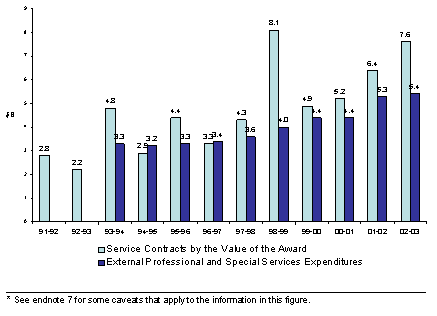
Rate increases versus work volume increases
On balance, it suits our purposes best to focus on the Public Accounts figures for external service contracts, since these report actual expenditures, as opposed to contract approvals. To interpret the cost increases demonstrated in this data, we need to assess to what extent the increases arose from increases in average daily rates versus increases in the volume of work contracted.
We have two very rough indicators on contracting rates. The first relates to legal services contracts. In that area, hourly rates have not changed since 1990, so the increase in the use of Crown agents between 1997–98 and 2002–03 must be largely a volume of work increase. Expenditures in that area grew from about $38.2 million in 1997–98 to about $63.3 million in 2002–03.[21] Using $1,000 per day as a rough average billing rate, this difference equals around 125 person‑years of additional legal work.
The second indicator comes from the experience of Consulting and Audit Canada (CAC). This agency of Public Works and Government Services Canada (PWGSC) handled about $120 million of business in 2002–03, or about 3% to 5% of the volume in the general areas in which it is active. Over the period from 1997–98 to 2002–03, CAC's own daily rates rose in the order of 20% to 25%; on a small sample of sub‑contractors, the changes varied from nothing to much larger proportions. Knowledgeable observers of consulting rates in the information management/information technology world report that consulting rates in the Ottawa market peaked in late 1999, but subsequently fell to the level of the mid‑1990s.
Based on this, we venture a very rough estimate of the increase in work volume represented by the increase of about $2 billion between 1997–98 and 2002–03 in external service contract expenditures reported in the Public Accounts. Rounding CAC's experience on daily rate increases up by 33% to ensure our estimate is conservative, we are left with a volume‑driven expenditure increase of about $1.4 billion. Using $800 per day as a rough average, this would be equivalent to about 8,750 person‑years of work.
From these rough assessments, we conclude that the increase in federal spending on service contracts between 1997–98 and 2003–03, combined with the services that have been privatized or devolved but which the federal government still funds, represents more than 10,000 person‑years of work on behalf of the federal government. This is almost certainly a low estimate.
We will not pursue this issue further in this study. But as we focus directly on growth in the public service, we need to bear in mind that the change in formal public service employment understates the growth in the volume of work purchased by the federal government. On this basis we can say that, by 2002–03, what could be called the federal government's "effective size" was at least as great as in 1990–91.
Increased spending for additional staff or salary increases
Expansion in the number of public servants can happen for one of two reasons.
First, political approval for new spending can occur through a Cabinet decision on some new initiative, or through a Treasury Board decision about funding for an existing program. Such decisions must be approved by Parliament through the Estimates process.
Second, managers within a department may transfer funding from non‑salary to salary expenditures, within their approved budgets. In both cases, change is the net effect of approved increases and decreases.
Policy Approval for new spending
Cabinet and parliamentary consideration of spending estimates tends to be very high level. It is the work of the Treasury Board, and more particularly the Treasury Board Secretariat, to scrutinize the details of spending plans, and to approve the allocation of funds to spending areas called "standard objects," of which the first (01) is for Personnel.
To be practical, we focus on growth since the end of Program Review, that is, from 1997–98 to 2002–03. While unravelling the ins and outs of change over the period of Program Review and before would be interesting, it is the employment expansion over these five years that needs attention in understanding the roots of our current investment in federal compensation.
Table 2016 provides details about the increases in employees and salary mass for those departments that grew by at least 500 employees between 1997–98 and 2002–03.
|
Table 2016 Increases in employment and total salaries for departments that grew by at least 500 employees between 1997–98 and 2002–03 |
|||||||||
|
Department |
Employees |
|
Equivalent salary ($M) |
||||||
|
1997–98 |
2002–03 |
Growth |
Growth |
1997–98 Current $ |
1997–98 (2002–03 Constant $) |
2002–03 Current $ |
Growth % (2002–03 Constant $) |
||
|
Canada Customs and |
40,437 |
48,927 |
8,490 |
21 |
1,541 |
1,719 |
2,381 |
39 |
|
|
Health Canada |
6,014 |
8,800 |
2,786 |
46 |
279 |
312 |
507 |
63 |
|
|
Correctional Services |
12,160 |
14,568 |
2,409 |
20 |
485 |
541 |
732 |
35 |
|
|
Agriculture and |
8,651 |
10,909 |
2,258 |
26 |
375 |
419 |
589 |
41 |
|
|
Justice |
2,556 |
4,754 |
2,198 |
86 |
145 |
162 |
324 |
101 |
|
|
Human Resources Development |
22,133 |
23,950 |
1,818 |
8 |
814 |
908 |
1,182 |
30 |
|
|
RCMP (civilian staff) |
3,461 |
4,810 |
1,350 |
39 |
105 |
117 |
204 |
75 |
|
|
Citizenship and Immigration |
3,815 |
5,154 |
1,340 |
35 |
150 |
167 |
261 |
56 |
|
|
Public Works and Government Services |
11,623 |
12,872 |
1,249 |
11 |
507 |
566 |
716 |
27 |
|
|
Foreign Affairs and International Trade** |
3,794 |
5,036 |
1,242 |
33 |
179 |
199 |
286 |
43 |
|
|
Canadian Heritage*** |
5,168 |
6,210 |
1,043 |
20 |
204 |
228 |
302 |
33 |
|
|
Environment |
4,607 |
5,619 |
1,012 |
22 |
237 |
265 |
342 |
29 |
|
|
Statistics Canada |
5,118 |
6,017 |
899 |
18 |
223 |
249 |
330 |
33 |
|
|
Fisheries and Oceans |
9,901 |
10,798 |
897 |
9 |
422 |
471 |
564 |
20 |
|
|
Industry |
4,727 |
5,613 |
886 |
19 |
228 |
254 |
335 |
32 |
|
|
Indian Affairs and Northern Development |
3,242 |
3,936 |
695 |
21 |
151 |
169 |
228 |
35 |
|
|
Natural Resources Canada |
3,869 |
4,538 |
670 |
17 |
199 |
222 |
280 |
26 |
|
|
National Research Council |
3,236 |
3,853 |
618 |
19 |
158 |
176 |
227 |
29 |
|
|
Sub‑total |
154,508 |
186,365 |
31,857 |
21 |
6,402 |
7,144 |
9,791 |
37 |
|
|
Other departments |
43,133 |
48,029 |
4,895 |
11 |
1,798 |
2,006 |
2,594 |
29 |
|
|
Total departments |
197,642 |
234,393 |
36,751 |
19 |
8,200 |
9,150 |
12,384 |
35 |
|
|
* Includes CFIA. |
|||||||||
Together these 18 departments and agencies accounted for about 31,900 of the net increase of around 37,000 employees in the combined core public service and separate employer domains, or more than 85%. The top five departments and agencies, namely the Canada Customs and Revenue Agency, Health Canada, the Correctional Service, Agriculture and Agri‑food (including the Canadian Food Inspection Agency), and the Department of Justice accounted for over 18,000 net new employees, almost half of the total growth.
The corresponding payroll increases displayed in Table 2016 include the impact of additional salaries and of salary increases. To explore to what extent the expansion of staff in these years resulted from funding approvals by Cabinet or by the Treasury Board, we looked at new funding for salaries authorized by the Treasury Board relating to the period from 1997–98 to 2002–03[22] for five organizations: CCRA, Health, Corrections, Justice, and Citizenship and Immigration. The approvals described were included in the Annual Reference Level Updates (ARLUs) of these departments. Our list is incomplete in that we did not attempt to add items included in Supplementary Estimates (although over time these move into the Main Estimates if they continue over multiple years), and even for the Main Estimates it is almost certain that we missed some items.
Canada Customs and Revenue Agency
The Canada Customs and Revenue Agency (now known as the Canada Revenue Agency, and before 1999 as Revenue Canada) added about 8,500 net additional employees between 1997–98 and 2002–03.[23] The agency's salary budget grew by about $850 million during these years. About $380 million of this growth resulted from specific Treasury Board approvals for new initiatives or increased operating costs.[24]
Five of the reasons[25] for these increases are described below.
Implementation of annual federal Budgets and new or revised laws
The net increase in salary costs for this purpose over five years was about $100 million. Included are amounts needed to implement tax changes or to adapt to revisions in laws such as the Employment Insurance Act, the Canada Pension Plan Act, or the Charities Act. During the period from 1997–98 to 2002–03, there were fundamental reforms in many of these fields. This area also included various investments relating to Government on Line, including developing the capacity to file tax returns on the Web, individual self‑service options, and simplifying payroll‑related requirements for businesses.
Program capacity renewal
About $155 million net was the salary increase in this broad area. The main basis for increases here was the Resource Management Review carried out by Pricewaterhouse Coopers in 2000. The review examined CCRA activities and resources over the preceding five years, and projected priorities and resource needs for the next five‑year period. Increased funding was approved to meet workload pressures, and to update and strengthen the agency's corporate services. In return, CCRA committed to productivity gains and increased revenues.
Border security/combating smuggling
Over $50 million was allocated for strengthening the border, post September 11th 2001, for other public security and anti‑terrorism measures, for combating smuggling, and for tobacco control.
Federal‑provincial cooperation
More than $40 million net in salaries was approved to provide support for the National Child Benefit and for the harmonized sales tax introduced in some provinces.
Compliance and enforcement
Around $30 million was approved to increase audits, including international audits, to pursue accounts receivable, and more generally for tax enforcement.
Health Canada
At Health Canada during the same five‑year span, employment increased by about 2,800 people. The total current‑dollar salary increase was about $230 million. Of this, nearly $70 million net reflected formal approval of new initiatives or funding of specific cost pressures. These approvals fell into the five areas described below.
Health policy and regulation
The need to strengthen the governance, surveillance and regulation of the blood system contributed importantly to a net increase of about $33 million in Health Canada salaries by 2002–03 compared with 1997–98. Other priorities funded under this heading were improvements to the drug approval system, and the national AIDS strategy.
Health services
A net amount of about $14.5 million was approved for various new or enhanced programs in such areas as Canadian Health Infostructure, Community Action Program for Children, prenatal nutrition, tobacco demand reduction, and combating diabetes.
Compliance and risk management
An additional $10 million net was provided to improve First Nations Health Services, and to enhance preventative and safety programs and regulation relating to food safety, pest management, and control of toxic substances, for example.
Research
Net salary budget increases totalling about $9.5 million aimed to promote health research and innovation.
Administrative capacity
A net total of around $2 million in salaries was made available for IT systems upgrades, and for strengthening the Department's administrative infrastructure. (This built on an increase of over $16 million approved in 1996–97, just before the period we are describing.)
Correctional Service Canada
For the Correctional Service, about 2,400 employees were added through the period. The salary mass increased by about $250 million, of which approximately $110 million resulted from policy and operational funding approvals. The three principal areas of such growth are described below.
Offender care and accommodation
Between 1997–98 and 2002–03 about $50 million net in additional salary funding was allocated in support of the CSC's national Capital, Accommodation and Operations Plan. Based on changes in cell utilization and the number and security level of offenders, the Plan funded needed accommodation, offender care, programming support, community corrections, and related infrastructure in such areas as information technology.
Enforcement policy
About $34 million in salaries was approved over the period for such purposes as:
- developing and testing new approaches to decrease recidivism and increase public safety;
- addressing the particular concerns of aboriginal offenders who are over‑represented in the correctional system;
- facilitating the capacity of communities to reintegrate offenders safely on release; and
- establishing a Canada Public Safety Information Network.
Program integrity
A net amount totalling about $27.5 million was added to salaries for training administrative staff, and to cover other measures to strengthen such areas as finance, human resources management, audit and evaluation, and records management.
Justice Canada
The Department of Justice nearly doubled in size, growing between 1997–98 and 2002–03 by about 2,200 employees on a 1997 base of 2,550. The department's salary mass expanded by about $180 million, with more than $80 million of this coming through policy and operational budget increases. The five main fields benefiting from these approvals are described below.
Program integrity
A net amount of about $46 million in new salary funding was authorized to augment the Department's capacity in such areas as strategic planning, legal risk management pilot projects, information management systems and technology, and improved human resources management.
Social programs
About $10.5 million was added to salaries net for additional work in such areas as youth justice renewal, crime prevention, victims assistance, child support and child‑centred family law more generally, and aboriginal justice.
Litigation and prosecution
Just over $10 million net was the increase in salaries relating to case management and advocacy. Expenditures in this area were driven by such factors as increases in prosecutions under the Controlled Drugs and Substances Act, and litigation in areas like residential school abuse cases, other aboriginal rights challenges, and immigration law.
Legal advice
Between 1997–98 and 2002–03, an additional $8 million was approved for Justice to augment its capacity to advise the government, as the common legal service provider to the federal government.
Legislative drafting
Almost $5 million in salary dollars was applied to meeting the demand for drafting statutes and regulations.
In the case of the Department of Justice, an important part of the employment growth between 1997–98 and 2002–03 was financed by cost recovery from client departments for litigation and legal advice. In 1997–98, such recoveries did not exceed $5 million; by 2002–03 they had reached about $117 million, approximately three quarters of which pays for salaries. Thus we estimate that at least $80 million of the $180 million total salary mass increase at Justice during these years came from client department cost recovery. Departments would have funded these costs through their own Cabinet submissions or Treasury Board submissions, or by internal reallocation.
Citizenship and Immigration Canada
Citizenship and Immigration (CIC) gained about 1,300 employees, with the salary total rising by about $110 million. Of this, more than half (just over $70 million) came through Cabinet or Treasury Board approvals for policy changes or to meet operational cost pressures. These increases can be summarized in the four categories listed below.
Public Security and Terrorism
About $31 million net was allocated post September 2001. Priorities funded included:
- increased vigilance at ports of entry;
- intelligence and interdiction;
- screening to reduce fraud;
- expanded detention and removals, as well as
- implementation of a new Permanent Resident Card.
Program integrity
A total of around $17 million net was provided to strengthen more generally the department's operations delivery infrastructure. This compliance and interdiction funding aimed to make it harder for illegal migrants to reach Canada. Investments covered:
- increased intelligence gathering;
- overseas interdiction (that is, greater emphasis on preventing irregular migration at the point of origin abroad);
- better screening and investigations; and
- more timely removals of those who are inadmissible.
Legislation and policy
To implement the 2001 Immigration and Refugee Protection Act and regulations, a net increase of about $14 million was allocated to CIC. Goals were improvements in family reunification and the selection system for skilled workers, refugee protection, and maintaining the safety of Canadian society.
Citizenship
A new Citizenship Act led to a net salary increase of about $8.5 million, covering such matters as new processes for deciding on applications for citizenship, appeals and revocation, and for dealing with individuals born of Canadian parents or adopted abroad.
These five examples from among the departments and agencies with the largest growth in jobs between 1997–98 and 2002–03 suffice to illustrate the diversity and nature of the policy and program reasons driving growth in the public service in this period. Many public policy goals required investments in people's knowledge and energy to succeed.
It is important to underline that the salary increases noted above relating to policy and operational budget approvals are presented net; that is, as the sum of increases and decreases over the years. For each department examined above there were decreases of various kinds. Examples included the final stages of Program Review budget reductions, repayment of loans provided to prepare for the year 2000 computer and software conversions, transfers of resources to other governments, the reprofiling of funds to future years, or reductions of spending on particular initiatives. Overall, however, the reductions during the 1997–98 to 2002–03 period were relatively small, and were overshadowed by the increases in most departments.
Taken together, the net difference in salary resources between 1997–98 and 2002–03 relating to policy approvals or Treasury Board decisions to meet operational budget pressures totalled in the range of $1.3 to $1.6 billion. In current dollars, for the combined core public service and separate employer domains, this constituted about one third of the total salary increase of about $4.2 billion.
Supplementary estimates
While we did not try systematically to capture salary increases approved through Supplementary Estimates, we encountered one example relating to CIC. As of 2002–03 the Treasury Board approved extra salary dollars totalling about $7.4 million in relation to the implementation of the Global Case Management System to replace and integrate the Department's core business systems and improve the quality of decision making on refugee claims, immigration and citizenship. This adds more than 10% to the incremental salary mass described above for CIC.
During the period under assessment, the use of Supplementary Estimates and amounts transferred to departments from Treasury Board votes occurred mainly to provide money to departments for approved salary increases. These increases would be the result of collective bargaining agreements or other wage determination processes, or pay equity settlements. These channels can also be used to support new hiring for new initiatives. As a case in point, we would cite government‑wide management initiatives such as Government on Line. In CCRA, for example, additional salary funding of about $1.8 million was transferred from Treasury Board to the Agency in 2000–01, rising to $2.5 million the following year. Through Supplementary Estimates for 2002–03, about $8.1 million in salary funds was provided for CCRA projects to improve internet access to services.
At most, such cases account for a net amount of $50 to $60 million in salary funding for new initiatives. Thus the total for policy initiatives would be worth around 30% of the $4.2 billion increase in the salary mass for the core public service and separate employers.
Internal transfers
The second source of salary dollars that can be used to finance employment growth is the transfer of funds within approved budgets, from non‑salary operating funds, capital, or grants and contributions, to salaries. Transfers into salaries require a mark‑up of 20% to cover the cost of associated employee benefits; conversely, transfers from salaries yield a 20% increase in the amount available for other purposes. In other words, to effect a transfer from operating funds to pay a $50,000 salary, $60,000 must be transferred. To increase operating funds by $60,000, a $50,000 transfer from the salary budget is sufficient; $60,000 will in fact be credited as the total transfer.
These transfers can occur in one of two ways:
- The first, a permanent transfer, is effected in cooperation with the Treasury Board Secretariat, through the annual reference level update (ARLU), and included in the Main Estimates.
- The second is an in‑year, temporary transfer into salaries. As long as the transfer is within an approved parliamentary vote total, the department may decide on and implement the transfer directly. Treasury Board Secretariat becomes aware later, as departments report on such transfers for the purpose of ensuring that the 20% premium for employee benefit costs is fully applied.
It is important to observe that both ARLU and in‑year transfers into salaries became much more significant in the most recent two years of our analysis. The net expansion in ARLU transfers between 1997–98 and 2002–03 relating to salaries was about $485 million for the whole government. In the absence of further details, we estimate that about three quarters[26] of this total—around $315 million—affected the core public service and the separate employer domains.
Table 2017 shows that net ARLU transfers for the government as a whole were negative until 1998–99. They then rose to the positive range of $100 to $150 million through 2000–01 and 2001–02, reaching over $400 million in 2002–03.
|
Table 2017 Summary of department‑initiated transfers into salaries from other approved budgets, 1997–98 to 2002–03 |
|||||||
|
Type of transfer |
$ millions |
||||||
|
1997–98 |
1998–99 |
1999–2000 |
2000–01 |
2001–02 |
2002–03 |
Net change |
|
|
ARLU* |
‑74.1 |
‑22.9 |
16.4 |
143.5 |
106.5 |
411.4 |
485.5 |
|
In‑year |
246.6 |
80.0 |
397.3 |
240.3 |
1,055.8 |
1,330.4 |
1,083.8 |
|
* Net changes from opening reference levels of 1995–96. |
|||||||
In‑year transfers accounted for a net increase in salary budgets of about $1.08 billion in 2002–03 compared with 1997–98. Based on an examination of the specific transfers, we estimate at about $865 million the portion of that total applying to the core public service and the separate employer domains. To arrive at this number we have subtracted transfers affecting organizations outside these domains (such as Parliament and the courts), as well as a prorated portion of transfers relating to National Defence and the RCMP.[27]
Growth in in‑year transfers was also large. Between 1997–98 and 2000–01, these amounted to between $80 million and $400 million. In 2001–02 these transfers into salaries implemented by departments surpassed $1 billion; in 2002–03 they reached $1.3 billion.
In order of size,[28] the source of funds to effect these transfers were capital, non‑personnel operating costs (things like travel and professional services), and grants and contributions. In some cases, revenue increases covered the transfers.
Departments decided to make such transfers for diverse reasons. A senior financial officer listed the reasons cited below regarding the experience of his large department.
Unfunded priorities
In the Department's judgement, some of the established business lines needed more staff than the Treasury Board felt could be covered by internal reallocation. Or the Department had to cope with an unexpected workload surge, for example.
Partial funding of a new initiative
In certain cases, the Treasury Board approved only part of the resources the department considered it needed to implement an approved policy.
Only non‑salary funding provided
New funding can come without a salary component, requiring some of the new money to be converted to salary dollars.
Reclassification
The department may decide to reclassify certain positions because of an increase in the level of skills required, but must fund the incremental cost internally, at least until the new group and level become included in the Department's salary base a few years later.
Under‑funding of collective agreements
In some cases, the Treasury Board covers only part of the extra salary costs arising from collective agreements negotiated by the Board's staff. This usually applies to staff hired after a bargaining round has begun. For rapidly growing departments, this shortfall can be substantial.
While not exhaustive, this list illustrates the types of situations that lead departments to convert non‑salary dollars to salary dollars. It is evident from these examples that such transfers can apply both to financing growth in the public service or to covering public servants' salary increases.
An initial Treasury Board analysis of this area draws the tentative conclusion that the bulk of department‑initiated transfers pay for costs arising from the need to finance reclassifications of positions, and to cover the balance payable given the incomplete funding of collective bargaining settlements. In the next chapter, we deduce from the available evidence that transfers were used in a somewhat smaller proportion to finance growth in the number of employees than to pay the cost of increased salaries.
For the combined core public service and separate employer domains, between 1997–98 and 2002–03 the total net increase in salary spending arising from ARLU and in‑year transfers was approximately $1.2 billion. Representing about 30% of the total net increase in the salary mass of $4.2 billion over that period, this is virtually the same proportion as for policy and workload approvals by Cabinet and the Treasury Board.
Changes in the composition of the workforce
During the period from 1990 to 2003 the structure of the federal public service workforce changed substantially. The simplest generalization is that while the knowledge and skill content of virtually all jobs increased in line with advances in technology and communications, those occupations with relatively high knowledge requirements grew rapidly, while less‑knowledge‑intensive jobs declined. As will be seen, this evolution put upward pressure on the average salary in the public service.
Changes by category
Prior to 1999, the public service distinguished six categories of classification groups:[29]
- administrative and foreign service,
- scientific and professional,
- technical,
- administrative support,
- operational, and
- executive.
We begin our analysis of structural change by observing the marked change in the relative size of these categories. Figure 2018 presents the population of employees[30] in each category for selected years from 1991 to 2003.
Figure 2018
Evolution of employee population by category for the combined core public service and separate employer domains, selected years from March 1991 to March 2003
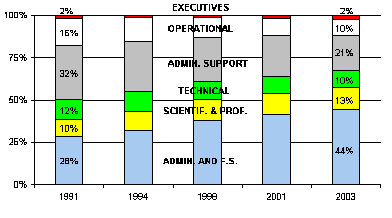
As Table 2019 shows, three categories have grown over the 12 years:
- Administrative and Foreign Service, by 51%;
- Scientific and Professional, by 22%;
- Executive, by 5%.
These categories gained nearly 37,000 members between 1998–99 and 2002–03.
Conversely, three groups have become smaller:
- Technical, by 21%;
- Administrative Support, by 38%;
- Operational category, by 42%.
|
Table 2019 Employee category* population change by sub‑periods |
|||||
|
Groups |
% Change |
Total |
|||
|
1991–94 |
1994–98 |
1998–01 |
2001–03 |
1991‑2003 |
|
|
Administrative and Foreign Service |
+10 |
‑1 |
+19 |
+17 |
+51 |
|
Scientific and professional |
+5 |
‑8 |
+13 |
+12 |
+22 |
|
Technical |
‑2 |
‑30 |
+8 |
+7 |
‑21 |
|
Administrative Support |
‑12 |
‑26 |
+1 |
‑5 |
‑38 |
|
Operational |
‑15 |
‑32 |
‑3 |
+3 |
‑42 |
|
Executives |
‑19 |
‑17 |
+23 |
+26 |
+5 |
|
Other groups in separate employers |
+126 |
‑55 |
+55 |
+13 |
+79 |
|
Total for all groups |
‑3 |
‑18 |
+10 |
+9 |
‑4 |
|
* Table 2019 includes for completeness, but not for analysis, a line entitled "Other groups in separate employers". This refers to groups unique to one or more separate employers that do not fit unambiguously in one of the six categories. |
|||||
Since Program Review there has been a modest rebound (about 15%) in the Technical category; the Administrative Support category has continued to shrink; and the Operational category has remained about the same, for a net increase of less than 1,000.
It needs mentioning that some of the decline in certain categories was the result of privatization or devolution. Most notably, several thousand former employees in the Technical category were transferred to NAVCAN (air traffic controllers), and others in the Operational category shifted, for example, to Brookfield, Lepage, Johnson Controls (trades specialists), and to St. Joseph Corporation (printing staff), to cite only cases that we discussed earlier in this chapter. Since the federal government still uses the latter two services, albeit through service contracts, the trends described in this section are somewhat mitigated in practice.
Figure 2020
Employee category populations, 1991 to 2003
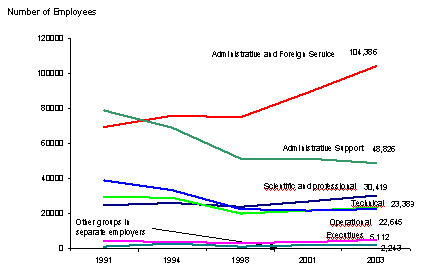
This pattern expresses unambiguously the observation that in general, growth correlated positively with knowledge intensity. Figure 2020, showing the movement over time, demonstrates that the trends were fairly persistent. For example, all categories shrank during the Program Review period from 1994 to 1998. It is evident that the overall declines to 1998 were not reversed, and all net growth since then has been in the more knowledge‑intensive categories. Taking the whole period from 1991 to 1998, the three declining categories lost about 53,100 members while the other three experienced a net gain of about 3,200.
Among the groups that have grown overall, it is noteworthy that the Executive category declined both before and during Program Review, falling by about one third in total. Since Program Review this reduction has been more than made up. The Administrative and Foreign Service category in effect only temporarily slowed its growth during Program Review, falling about 1%. The Scientific and Professional category did shrink, but rebounded and grew strongly.
Changes by classification group
We now look at the evolution of those classification groups that had at least 2,000 members in March 2003. This discussion draws on the figures presented in Appendix M.[31]
Figures 2021 to 2023 illustrate many of the trends described in this section. The most rapidly declining groups, which each lost at least 20% of their members, are set out in Figure 2021. All fall within the old Administrative Support or Operational categories.
Figure 2021
Population evolution for classification groups that declined by at least 20%,* 1991 to 2003
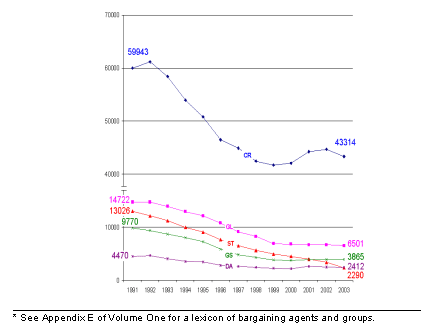
Figures 2022 and 2023
Population evolution of classification groups that grew by at least 50%, 1991 to 2003*
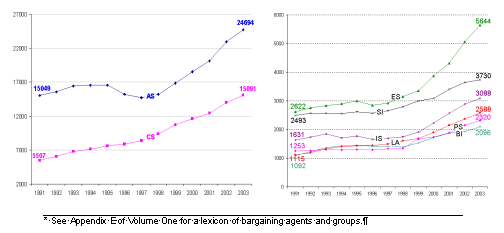
Looking from the perspective of absolute size, the principal classification groups affected (those losing at least 2,000 members) were as follows:
|
(CR) Clerical and Regulatory |
‑16,629 |
|
(ST) Stenographic and Typing |
‑10,736 |
|
(GL) General Labour and Trades |
‑8,221 |
|
(GS) General Services |
‑5,905 |
|
(DA) Data Processing |
‑2,058 |
These groups lost in total over 43,500 members between 1991 and 2003.
The fastest growing groups (those increasing by at least 50%) in percentage terms between 1991 and 2003 are shown in Figures 2022 and 2023.
Four classification groups, which each experienced growth of more than 3,000 employees, contributed about two thirds of the population increase in the combined core public service and separate employer domains, as follows:
|
Group |
Growth |
|
(CS) Computer Systems |
9,584 |
|
(AS) Administrative Services |
9,645 |
|
(PM) Program Administration |
6,530 |
|
ES) Economists/Statisticians |
3,022 |
These are large groups, so their prominence in absolute growth is not surprising in principle. However, their proportion of the 2003 population is only about half as great (about 35%) as their share of the growth between 1991 and 2003.
Take‑up rates for Program Review Departure Incentives
For the Program Review downsizing period in the mid‑1990s, we reviewed the pattern by classification group of employee separations under two programs established to encourage staff reductions. A total of about 35,500 employees participated in these programs.
The Early Departure Incentive (EDI) provided a cash payment to employees who agreed to resign voluntarily from the Public Service. The amount of the payment varied according to an employee's salary, age, years of service and eligibility for pension benefits. About 19,700 employees participated.
The Early Retirement Incentive (ERI) waived age or years‑of‑service penalties for employees at least 50 years old who chose to retire before their normal eligibility date. About 12,700 employees participated in this program.
Also operative were the general policies embodied in the Workforce Adjustment Directive (WFAD), and the Executive Employment Transition Policy (EETP).
Our hypothesis was that a disproportionately large share of employees from declining classification groups participated. A review of Table 2024 shows that there is some tendency in this direction, but it is not marked among the larger groups. For example, participants from the Clerical and Regulatory (CR) group were less prominent among EDI/ERI participants (i.e. 6,852 out of 35,557 or 19.2%) than their proportion of the public service (22.4%) in March 1995, just after the downsizing goals were announced. The second largest group, the Program Administration (PM) classification group, was also underrepresented with 11.4% of the EDI/ERI participants but 15.7% of the March 1995 population.
|
Table 2024 Participants in the Early Departure Incentive (EDI) and Early Retirement Incentive (ERI) programs by classification group |
|||||||
|
Occupational group* |
ERI |
EDI** |
WFAD |
EETP |
Total departure programs |
Take‑up rate % |
Share of March 1995 population % |
|
CR |
2,172 |
4,093 |
587 |
0 |
6,852 |
13.6 |
22.4 |
|
PM |
2,178 |
1,477 |
379 |
2 |
4,036 |
11.4 |
15.7 |
|
GL |
697 |
2,629 |
185 |
0 |
3,511 |
28.9 |
5.4 |
|
AS |
1,432 |
1,276 |
247 |
0 |
2,955 |
19.0 |
6.9 |
|
GS |
340 |
2,138 |
90 |
0 |
2,568 |
35.6 |
3.2 |
|
EG |
743 |
965 |
127 |
0 |
1,835 |
24.9 |
3.3 |
|
ST |
478 |
1,121 |
137 |
0 |
1,736 |
19.4 |
4.0 |
|
PE |
355 |
258 |
47 |
0 |
660 |
20.8 |
1.4 |
|
EN |
200 |
400 |
42 |
0 |
642 |
22.1 |
1.3 |
|
EX |
584 |
25 |
6 |
371 |
986 |
26.4 |
1.7 |
|
CS |
185 |
287 |
47 |
0 |
519 |
7.0 |
3.3 |
|
ES |
155 |
146 |
30 |
0 |
331 |
11.1 |
1.3 |
|
Other groups |
3,182 |
4,916 |
807 |
21 |
8,926 |
13.1 |
30.2 |
|
Total |
12,701 |
19,731 |
2,731 |
394 |
35,557 |
15.8 |
100.0 |
|
* Core public service domain only. |
|||||||
For smaller declining groups, however, a substantially larger proportion did leave. The cases of the General Services (GS) and the General Labour and Trades (GL) groups stand out in this regard. For example, the proportion of departing GS employees (35.6%) was over 10 times their share of the March 1995 population. For both the Executive (EX) and the Personnel Administration (PE) groups the ratio was about 15 to 1 between share of departures and share of the March 1995 population. Less dramatically, the EDI/ERI participation among the Secretarial, Stenographic and Typing (ST) group (4.8%) was also larger than its share of the March 1995 population (4.0%).
Conversely, among some of the fastest growing groups relatively few employees participated in the EDI/ERI programs. This is evident in the cases of Computer Systems (CS), and the Economics, Sociology and Statistics (ES) groups, for example. For these groups, the take‑up rate of departure incentives was 7% and 11.1% respectively, well below the average take‑up rate of 15.8%. Their proportion of EDI/ERI participants were also well below their shares of the March 1995 population, at 1.5% versus 3.3% of the March 1995 population (CS group), and 0.9% versus 1.3% (ES group) respectively.
As an overall conclusion on this point, we view the Program Review downsizing period as contributing modestly, at most, to a much larger process of transformation that began before this period and continued afterwards.
The data presented in this section suggests at least three comments. First, the pattern of growth and decline by classification group reflects even more clearly than the analysis by employee category the correlation of growth with the relative knowledge intensity of a group's work. Change on this scale implies a fundamental change in the nature of the public service. Second, the fact that there were declines in just five groups totalling over 40,000 while the net outcome across the whole public service was growth of about the same magnitude, suggests that thousands of employees switched groups. The greatest example of this trend is the movement of ST and CR employees into the AS classification group. The Stenographic and Typing (ST) group is apparently en route to disappearing, having declined by 82% in 12 years. Of 670 ST employees reclassified in 2002, all but 29 moved to another group, either CR or AS. Finally, in general those groups that are growing have higher salaries than those that are shrinking, contributing inevitably to an increase in the average salary in the public service.
Changes in the distribution of employees by level within classification groups
We also looked closely at changes in the distribution of employees by level within key classification groups, to determine whether higher classification levels are driving average salaries upward. The population for each classification level of 13 selected groups, representing about two thirds of the current public service, is given in table form in Appendix G,[32] for selected years between 1991 and 2003. Bar charts compare the percentage of the population at each level for 1991, 1998 and 2003.
Overall, this analysis shows considerable stability in the percentage distribution of employees by level. Figure 2025 illustrates this point clearly for the Program Administration (PM) classification group. Despite overall growth of about 20% between 1991 and 2003 to about 38,300 employees in March 2003, the basic pattern has held. The only discernable trends are small: level 1 declined from 25% to 22%; level 4 grew from 11% to 13%; and level 5 increased from 7% to 9%.
Similarly stable was the Financial Administration (FI) group. For each of the group's four levels, the proportion of employees varied by no more than 2%, comparing 1991 to 2003.
Figure 2026 illustrates that the Clerical and Regulatory (CR) classification group, on the other hand, shows a clear trend away from the lower to the higher levels. Despite having declined by 28% as noted earlier, the CR group remains the largest at about 43,300 in March 2003 in the combined core public service and separate employer domains. The CR 1 level had already in effect disappeared by 1991. Level 2 shrank from 15% to 6%, and level 3 from 35% to 24%. By contrast, level 4 grew from 37% to 47%, and level 5 almost doubled from 12% to 23%. Such proportionate changes within such a numerous group would certainly put upward pressure on the average public service salary.
Another group with a clear upward pattern in the structure was the Personnel Administration (PE) group, as shown in Figure 2027. Level 2 fell from 19% to 12% between 1991 and 2003, and level 3 fell from 42% to 29%. The higher levels all increased in proportion: level 4 from 20% to 28%, level 5 from 11% to 16%, and level 6 from 5% to 9%.
Figure 2025
Program Administration (PM) group,
Population distribution by level, 1991, 1998 and 2003
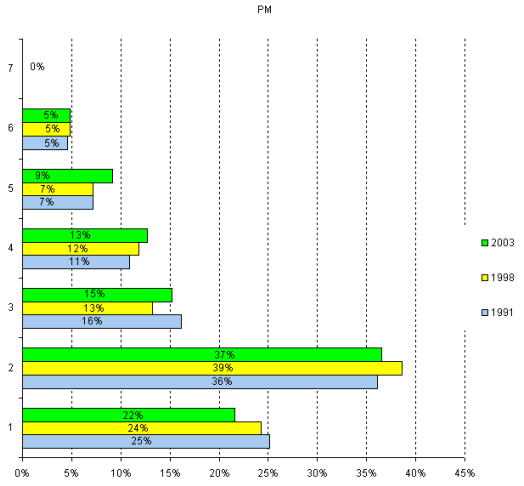
Figure 2026
Clerical and Regulatory (CR) group,
Population distribution by level, 1991, 1998 and 2003
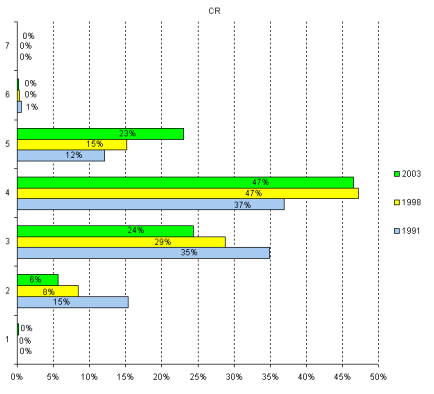
Figure 2027
Personnel Administration (PE) group,
Population distribution by level, 1991, 1998 and 2003
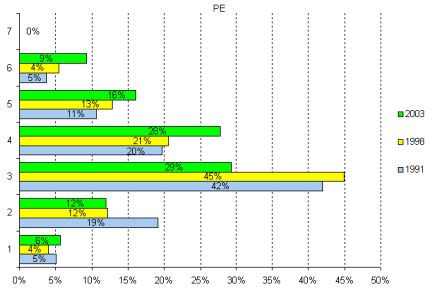
Figure 2028
Administrative Services (AS) group,
Population distribution by level, 1991, 1998 and 2003
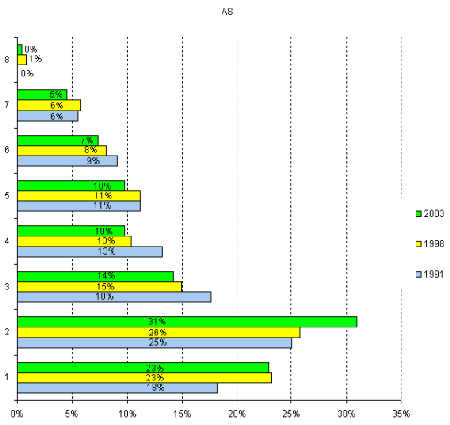
For some other groups the picture is mixed. For example, as Figure 2028 illustrates, the Administrative Services (AS) group saw increases at the lowest levels, from 18% to 23% at AS 1 and 25% to 31% at AS 2. The next two levels fell in relative terms, and the highest levels stayed fairly constant. Although we could not carry out the detailed analysis to trace the movement of individuals, strong anecdotal evidence indicates that the growth in the first two AS levels reflects the progression of employees formerly in the CR and ST groups.
Two other patterns of interest relate to the Computer Systems (CS) and the Executive (EX) groups. The CS structure remained quite stable in the middle three levels despite being the fastest growing group, while the CS 1 level grew as a proportion from 19% to 24%. The top CS 5 level remained small at 2%, but the absolute growth from 16 to 262 over the twelve years was noteworthy. For the EX group, there was a decline at the EX 1[33] level from 65% to 53%, increases at EX 2 from 18% to 25% and at EX 3 from 10% to 16%. The top two EX levels remained unchanged at 5% and 2% respectively.
With an understanding of the employment growth and classification shifts that contributed to salary changes in the core public service and separate employer domains, we now turn to the structural change that contributed to the changes both in employment and average salary.
